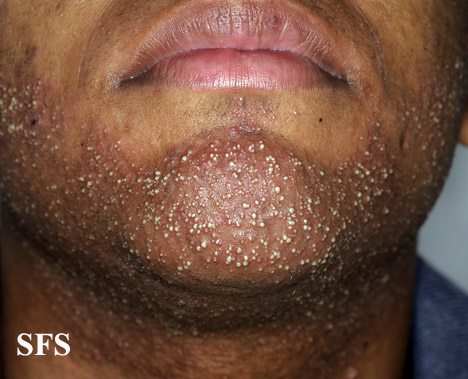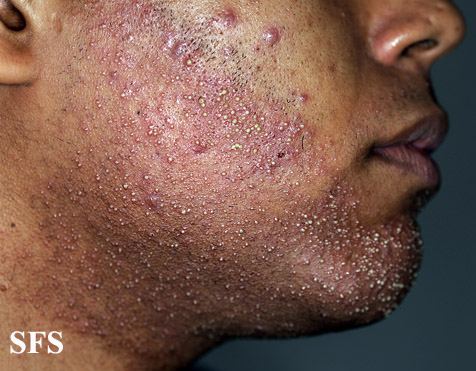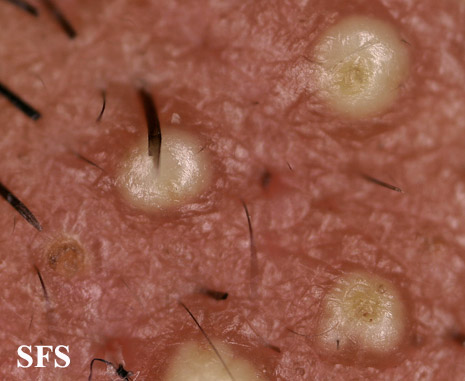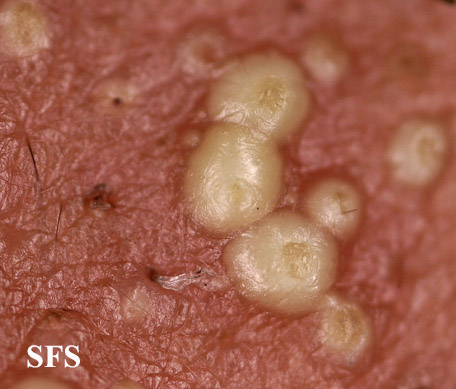Pseudofolliculitis barbae
Editor-In-Chief: C. Michael Gibson, M.S., M.D. [1]; Associate Editor(s)-in-Chief: Jesus Rosario Hernandez, M.D. [2] Kiran Singh, M.D. [3]
Synonyms and keywords:: Folliculitis of barbae.
Overview
Pseudofolliculitis barbae (pronounced /Template:IPA/) is a medical term for persistent inflammation caused by shaving. The etymology comes from "pseudo" (false) "follicle" (hair) "itis" (inflammation) "barbae" (of the beard). It is also known by the initials PFB or colloquial terms such as "razor bumps."
Etiology
PFB is most common on the male face, but it can also happen on other parts of the body where hair is shaved or plucked, especially areas where hair is curly and the skin is sensitive, such as genital shaving (more properly termed pseudofolliculitis pubis or PFP).
After a hair has been shaved, it begins to grow back. Curly hair tends to curl into the skin instead of straight out the follicle. PFB can make the skin look itchy and red, and in some cases, it can even look like pimples. These inflamed papules or pustules can form especially if the area becomes infected.
This is especially problematic for men of African descent and other people with curly hair. If left untreated over time, this can cause keloid scarring in the beard area.
Pseudofolliculitis Barbae can further be divided into two types of ingrown hairs: transfollicular and extrafollicular. The extrafollicular hair is a hair that has exited the follicle and reentered the skin. The transfollicular hair never exits the follicle, but because of its naturally curly nature curls back into the follicle causing fluid build-up and irritation. Men of African, Mediterranean, Jewish, Nordic, and other people who have naturally coarse or tightly curling hair will often get 'razor bumps' in their beards.
Prevention and treatment
Prevention and treatment varies by person.
Prevention
Some males use shaving powders (a kind of chemical depilatory) to avoid the irritation. Others may use a razor with a single blade or special wire-wrapped blade to avoid shaving too closely. Some men trim or grow a beard instead of shaving. In severe cases or in occupations where shaving is a requirement (such as the military), some men get electrolysis, laser hair removal, or use exfoliating products to minimize PFB.
An effective prevention is to let the beard grow. Once the hairs get to be a certain length they will not grow back into the skin. For most cases, totally avoid shaving for three to four weeks until all lesions have subsided, while applying a mild prescription cortisone cream to the involved skin each morning.
Shaving every other day, rather than daily, will improve pseudo-folliculitis barbae. If one must use a blade, water soften the beard first with a hot, wet washcloth for five minutes.
Electrolysis and laser hair removal should be considered when all else fails, but these are expensive and take repeated visits. There is a very small risk of scarring. A few insurance companies will cover some or all of the cost.
Medications are also prescribed to speed healing of the skin. Glycolic acid lotion 8% (Alpha-hydrox, Neo-Strata, others) is effective. Prescription antibiotic gels (Benzamycin, Cleocin-T) or oral antibiotics are also used. Retin-A is a potent treatment that helps even out any scarring after a few months. It is added as a nightly application of Retin-A Cream 0.05 - 0.1% to the beard skin while beard is growing out. Use as tolerated, as it is somewhat irritating.
Treatment
Existing razor bumps can often be treated by removal of the ingrown hair. Extrafollicular hairs can usually be pulled from under the skin, or removed entirely, with tweezers. Severe or transfollicular hairs may require removal by a dermatologist.
Related conditions
Razor burn is a less serious condition caused by shaving, characterized by mild to moderate redness and irritation on the surface of the skin. Unlike PFB, it is usually transient and there is no infection involved.
There is also a condition called folliculitis barbae. The difference between the two is the cause of the inflammation in the hair follicles. Folliculitis barbae is caused by viral or bacterial infections, where pseudofolliculitis is caused by irritation from shaving and ingrown hairs.
A related condition, Pseudofolliculitis nuchae, occurs on the back of the neck, often along the posterior hairline, when curved hairs are cut short and allowed to grow back into the skin. Left untreated, this can develop into acne keloidalis nuchae, a condition where hard, dark keloid-like bumps form on the neck.
Diagnosis
Physical examination
Skin
=Face
-
Pseudofolliculitis barbae. With permission from Dermatology Atlas.[1]
Neck
-
Pseudofolliculitis barbae. With permission from Dermatology Atlas.[1]
-
Pseudofolliculitis barbae. With permission from Dermatology Atlas.[1]
-
Pseudofolliculitis barbae. With permission from Dermatology Atlas.[1]
-
Pseudofolliculitis barbae. With permission from Dermatology Atlas.[1]
-
Pseudofolliculitis barbae. With permission from Dermatology Atlas.[1]
-
Pseudofolliculitis barbae. With permission from Dermatology Atlas.[1]
-
Pseudofolliculitis barbae. With permission from Dermatology Atlas.[1]
-
Pseudofolliculitis barbae. With permission from Dermatology Atlas.[1]
-
Pseudofolliculitis barbae. With permission from Dermatology Atlas.[1]
-
Pseudofolliculitis barbae. With permission from Dermatology Atlas.[1]
-
Pseudofolliculitis barbae. With permission from Dermatology Atlas.[1]
-
Pseudofolliculitis barbae. With permission from Dermatology Atlas.[1]
-
Pseudofolliculitis barbae. With permission from Dermatology Atlas.[1]
-
Pseudofolliculitis barbae. With permission from Dermatology Atlas.[1]
-
Pseudofolliculitis barbae. With permission from Dermatology Atlas.[1]
-
Pseudofolliculitis barbae. With permission from Dermatology Atlas.[1]
-
Pseudofolliculitis barbae. With permission from Dermatology Atlas.[1]
-
Pseudofolliculitis barbae. With permission from Dermatology Atlas.[1]
-
Pseudofolliculitis barbae. With permission from Dermatology Atlas.[1]
-
Pseudofolliculitis barbae. With permission from Dermatology Atlas.[1]
-
Pseudofolliculitis barbae. With permission from Dermatology Atlas.[1]
-
Pseudofolliculitis barbae. With permission from Dermatology Atlas.[1]
-
Pseudofolliculitis barbae. With permission from Dermatology Atlas.[1]
-
Pseudofolliculitis barbae. With permission from Dermatology Atlas.[1]
-
Pseudofolliculitis barbae. With permission from Dermatology Atlas.[1]
-
Pseudofolliculitis barbae. With permission from Dermatology Atlas.[1]
-
Pseudofolliculitis barbae. With permission from Dermatology Atlas.[1]
-
Pseudofolliculitis barbae. With permission from Dermatology Atlas.[1]
-
Pseudofolliculitis barbae. With permission from Dermatology Atlas.[1]
-
Pseudofolliculitis barbae. With permission from Dermatology Atlas.[1]
-
Pseudofolliculitis barbae. With permission from Dermatology Atlas.[1]
-
Pseudofolliculitis barbae. With permission from Dermatology Atlas.[1]
-
Pseudofolliculitis barbae. With permission from Dermatology Atlas.[1]
-
Pseudofolliculitis barbae. With permission from Dermatology Atlas.[1]
-
Pseudofolliculitis barbae. With permission from Dermatology Atlas.[1]
-
Pseudofolliculitis barbae. With permission from Dermatology Atlas.[1]


![Pseudofolliculitis barbae. With permission from Dermatology Atlas.[1]](/images/3/3e/Pseudofolliculitis_barbae01.jpg)
![Pseudofolliculitis barbae. With permission from Dermatology Atlas.[1]](/images/e/ef/Pseudofolliculitis_barbae02.jpg)
![Pseudofolliculitis barbae. With permission from Dermatology Atlas.[1]](/images/c/c0/Pseudofolliculitis_barbae03.jpg)
![Pseudofolliculitis barbae. With permission from Dermatology Atlas.[1]](/images/c/c3/Pseudofolliculitis_barbae04.jpg)
![Pseudofolliculitis barbae. With permission from Dermatology Atlas.[1]](/images/7/7b/Pseudofolliculitis_barbae05.jpg)
![Pseudofolliculitis barbae. With permission from Dermatology Atlas.[1]](/images/7/7f/Pseudofolliculitis_barbae06.jpg)
![Pseudofolliculitis barbae. With permission from Dermatology Atlas.[1]](/images/a/a6/Pseudofolliculitis_barbae07.jpg)
![Pseudofolliculitis barbae. With permission from Dermatology Atlas.[1]](/images/b/bb/Pseudofolliculitis_barbae08.jpg)
![Pseudofolliculitis barbae. With permission from Dermatology Atlas.[1]](/images/2/28/Pseudofolliculitis_barbae09.jpg)
![Pseudofolliculitis barbae. With permission from Dermatology Atlas.[1]](/images/4/46/Pseudofolliculitis_barbae10.jpg)
![Pseudofolliculitis barbae. With permission from Dermatology Atlas.[1]](/images/7/7a/Pseudofolliculitis_barbae11.jpg)
![Pseudofolliculitis barbae. With permission from Dermatology Atlas.[1]](/images/5/56/Pseudofolliculitis_barbae12.jpg)
![Pseudofolliculitis barbae. With permission from Dermatology Atlas.[1]](/images/9/90/Pseudofolliculitis_barbae13.jpg)
![Pseudofolliculitis barbae. With permission from Dermatology Atlas.[1]](/images/c/c4/Pseudofolliculitis_barbae14.jpg)
![Pseudofolliculitis barbae. With permission from Dermatology Atlas.[1]](/images/0/04/Pseudofolliculitis_barbae15.jpg)
![Pseudofolliculitis barbae. With permission from Dermatology Atlas.[1]](/images/8/86/Pseudofolliculitis_barbae16.jpg)
![Pseudofolliculitis barbae. With permission from Dermatology Atlas.[1]](/images/e/e2/Pseudofolliculitis_barbae17.jpg)
![Pseudofolliculitis barbae. With permission from Dermatology Atlas.[1]](/images/a/a9/Pseudofolliculitis_barbae18.jpg)
![Pseudofolliculitis barbae. With permission from Dermatology Atlas.[1]](/images/a/a1/Pseudofolliculitis_barbae19.jpg)
![Pseudofolliculitis barbae. With permission from Dermatology Atlas.[1]](/images/e/ef/Pseudofolliculitis_barbae20.jpg)
![Pseudofolliculitis barbae. With permission from Dermatology Atlas.[1]](/images/c/c9/Pseudofolliculitis_barbae21.jpg)
![Pseudofolliculitis barbae. With permission from Dermatology Atlas.[1]](/images/4/42/Pseudofolliculitis_barbae22.jpg)
![Pseudofolliculitis barbae. With permission from Dermatology Atlas.[1]](/images/0/0c/Pseudofolliculitis_barbae27.jpg)
![Pseudofolliculitis barbae. With permission from Dermatology Atlas.[1]](/images/5/5b/Pseudofolliculitis_barbae28.jpg)
![Pseudofolliculitis barbae. With permission from Dermatology Atlas.[1]](/images/0/0c/Pseudofolliculitis_barbae29.jpg)


![Pseudofolliculitis barbae. With permission from Dermatology Atlas.[1]](/images/4/49/Pseudofolliculitis_barbae23.jpg)
![Pseudofolliculitis barbae. With permission from Dermatology Atlas.[1]](/images/5/56/Pseudofolliculitis_barbae24.jpg)
![Pseudofolliculitis barbae. With permission from Dermatology Atlas.[1]](/images/c/c8/Pseudofolliculitis_barbae25.jpg)
![Pseudofolliculitis barbae. With permission from Dermatology Atlas.[1]](/images/c/c3/Pseudofolliculitis_barbae26.jpg)
![Pseudofolliculitis barbae. With permission from Dermatology Atlas.[1]](/images/f/f0/Pseudofolliculitis_barbae30.jpg)
![Pseudofolliculitis barbae. With permission from Dermatology Atlas.[1]](/images/d/d8/Pseudofolliculitis_barbae31.jpg)
![Pseudofolliculitis barbae. With permission from Dermatology Atlas.[1]](/images/a/a1/Pseudofolliculitis_barbae32.jpg)
![Pseudofolliculitis barbae. With permission from Dermatology Atlas.[1]](/images/e/ec/Pseudofolliculitis_barbae33.jpg)
![Pseudofolliculitis barbae. With permission from Dermatology Atlas.[1]](/images/d/da/Pseudofolliculitis_barbae34.jpg)
![Pseudofolliculitis barbae. With permission from Dermatology Atlas.[1]](/images/4/42/Pseudofolliculitis_barbae35.jpg)
![Pseudofolliculitis barbae. With permission from Dermatology Atlas.[1]](/images/d/dc/Pseudofolliculitis_barbae36.jpg)
![Pseudofolliculitis barbae. With permission from Dermatology Atlas.[1]](/images/6/60/Pseudofolliculitis_barbae37.jpg)